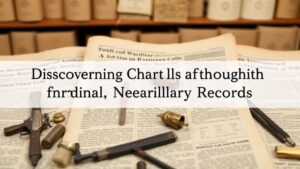Top Techniques for Uncovering Treasure Legends and Verifying Clues
Top Techniques for Uncovering Treasure Legends and Verifying Clues
Treasures lost to time, rumored to be hidden in the nooks and crannies of our worlds history, captivate the imagination. Throughout history, treasure legends have inspired treasure hunts and motivated countless adventurers. But, uncovering the truth behind these legends requires a systematic approach. This article outlines the best techniques for researching treasure legends and verifying the clues that accompany them, contributing to both historical scholarship and practical treasure hunting.
Historical Context and Documentation
The first step in uncovering treasure legends is understanding their historical context. Many legends are rooted in real events, often intertwined with exploration, war, or economic transactions. For example, the story of the “Lost Dutchman’s Gold Mine†in Arizona is linked to the states tumultuous mining history during the 19th century. Historians suggest the legend emerged from the interactions between European settlers and Native Americans, demanding rigorous examination of historical records and artifacts.
Primary sources such as letters, diaries, and official documents play a crucial role in verifying these stories. Researchers are advised to visit state archives, local libraries, or historical societies where original documents may be preserved. Secondary sources include books and articles written by historians who have analyzed these documents and can provide context for the legends.
- Use state archives and libraries to access primary historical documents.
- Examine scholarly articles for critical analyses of well-known legends.
Field Research and Site Analysis
After gathering historical data, the next essential technique involves conducting field research. This includes visiting the actual locations associated with treasure legends. Observations in the field can yield useful information, such as the geography and ecology of a site, which can provide clues to the plausibility of a treasure existing there. For example, the infamous “Cursed Treasure of Oak Island†in Nova Scotia has prompted extensive excavations and examinations. Researchers have employed geophysical surveys to detect anomalies beneath the surface, leading to discoveries of artifacts that suggest human activity.
Topographical maps and remote sensing technologies can also assist in analyzing sites effectively. Historical actions often leave physical evidence, and modern geolocation tools can pinpoint areas of interest for potential treasure sites. For example, metal detectors and ground-penetrating radar (GPR) can be leveraged to investigate underground structures related to treasure clues.
- Employ geophysical techniques to evaluate underground features.
- Assess historical topographical maps to understand site geography.
Oral Histories and Local Legends
Engagement with local communities can be invaluable as they often possess oral histories that provide insights not found in written records. Local legends, passed down through generations, can reveal possible locations of treasures or forgotten details about historical events. For example, the Atocha treasure, discovered off the coast of Florida, has a background steeped in local lore regarding the shipwreck and the wealth it carried. Conversations with locals may uncover previously unknown clues that could enhance treasure-hunting strategies.
When collecting oral histories, it is crucial to document the narratives accurately, establishing their sources and contexts. Asking permission from storytellers to record their accounts fosters community trust and engagement, essential for collaborative historical research.
- Record oral histories from local sources to gather unique perspectives.
- Build relationships with community members to enhance research credibility.
Utilizing Technology
In the current era, technology plays an essential role in uncovering and verifying treasure legends. Geographic Information Systems (GIS) can analyze and visualize spatial relationships across vast datasets, enabling researchers to identify trends or patterns previously unnoticed. For example, GIS technology has been instrumental in mapping the dynamics surrounding pirate activities in the Caribbean, allowing treasure hunters to focus their searches based on historical pirate routes.
Social media and online forums also serve as platforms to connect with other treasure hunters and historians. Engaging with dedicated communities can lead to the sharing of critical information, tips, and resources that can aid in treasure verification efforts.
- Leverage GIS tools for spatial analysis and visualization of treasure sites.
- Participate in online forums to access shared knowledge and experiences.
Verification through Scientific Methods
Finally, the application of scientific methods is crucial in verifying clues and establishing facts surrounding treasure legends. Techniques such as radiocarbon dating can be employed to confirm the age of artifacts associated with treasurable items. For example, environmental archaeology can analyze soil samples to reveal previous human activity in an area, confirming whether it aligns with documented treasure legends.
Also, comparative analysis of materials can suggest trade routes and connections between different cultures, reflecting on the flow of potential treasure. As an illustrative case, the treasures associated with the Spanish Conquistadors often exhibited a blend of indigenous and European materials, prompting interdisciplinary studies that delve into historical interactions.
- Use radiocarbon dating to establish the age of related artifacts.
- Conduct comparative analyses of materials to understand cultural connections.
Conclusion
Uncovering treasure legends requires a multifaceted approach that combines historical analysis, fieldwork, community engagement, technological advancements, and scientific methods. These techniques can help restore historical context to legends and enhance the chances of treasure verification. Aspiring treasure hunters and historians alike can benefit from a systematic methodology that embraces both traditional scholarship and modern innovations.
By applying these techniques, researchers and adventurers not only seek tangible rewards but also contribute to a deeper understanding of our shared heritage. With careful investigation, the truth behind treasure legends may emerge, illuminating the complex narratives woven through time.



